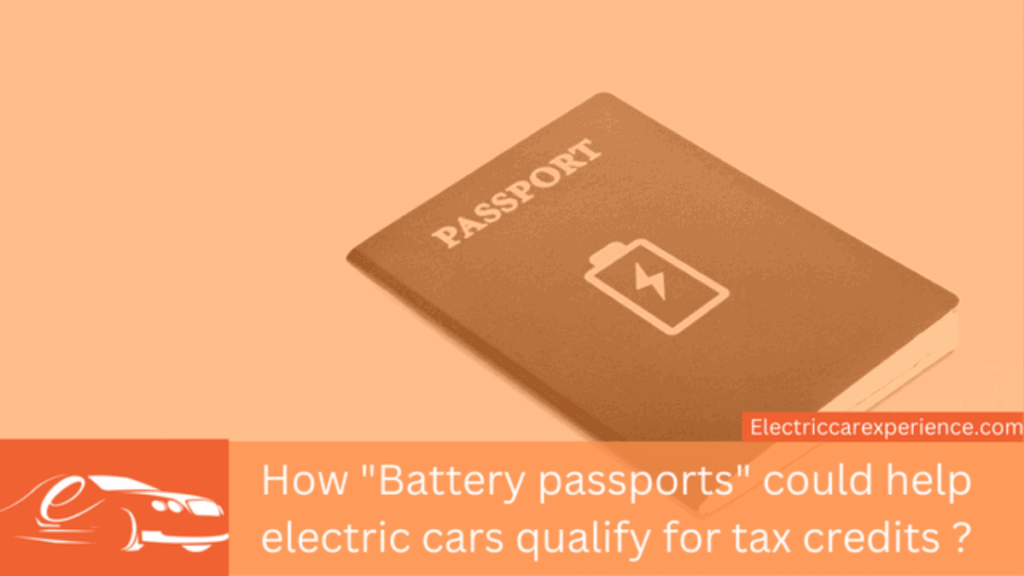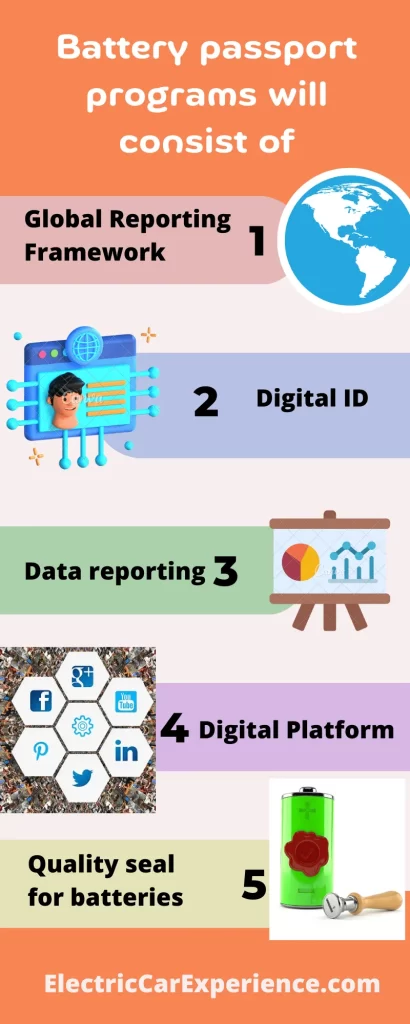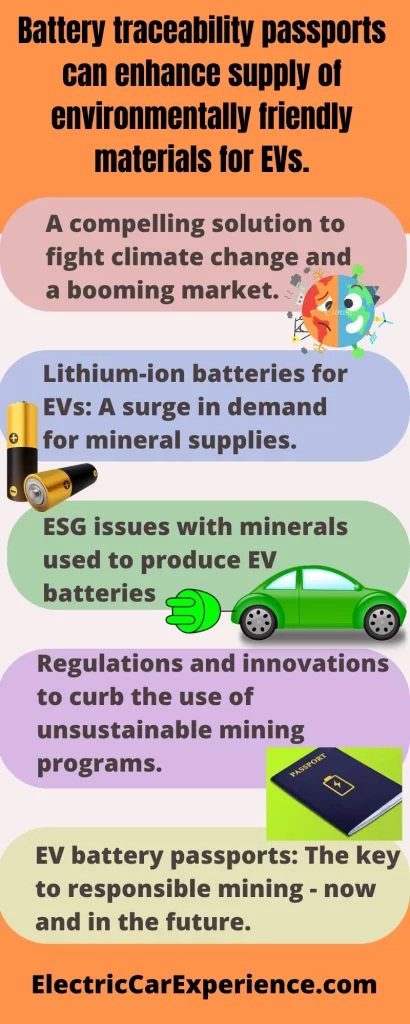
A “battery passport” is a document that tracks the life cycle of an electric vehicle’s (EV) battery, including its manufacture, installation, use, and eventual disposal or recycling. By providing detailed information about the battery’s condition and history, a battery passport could help electric cars qualify for tax credits.How Battery Passports Could Help Electric Cars Qualify For Tax Credits?
A battery passport could help address this issue by providing a detailed record of the battery’s performance and history, allowing regulators to more accurately assess the battery’s value and eligibility for tax incentives. Currently, many countries offer tax incentives for the purchase of electric vehicles, including tax credits that are based on the size of the vehicle’s battery. However, some of these incentives are tied to the battery’s capacity and range, and may be reduced or eliminated if the battery’s performance degrades over time.
For example, if a battery has a history of good performance and has been well-maintained, it may be more likely to qualify for tax credits even if its capacity has degraded slightly over time.
Additionally, a battery passport could help promote transparency and accountability in the electric vehicle industry by providing consumers with more information about the batteries in their vehicles. This could help build trust in the technology and encourage more people to switch to electric cars.
Overall, battery passports could play an important role in promoting the adoption of electric vehicles and supporting the transition to a more sustainable transportation system.
A maximum tax credit for electric car models according to IRS in the year 2015.
| 2015 Electric Car Model | Maximum Tax Credit for Electric Cars |
|---|---|
| Toyota Prius Plug-in Hybrid | $2,500 |
| Porsche 918 Spyder | $3,667 |
| BMW i8 | $3,793 |
| Ford CMAX Energy, Ford Fusion Energy | $4,007 |
| Porsche Panamera S E-Hybrid | $4,752 |
| Porsche Cayenne S E-Hybrid | $5,335 |
| BMW i3, Cadillac ELR, Chevrolet Spark, Chevrolet Volt, Chrysler/Fiat 500e, Ford Focus EV | $7,500 |
| 2014 Tesla Model S | $7,500 |
After searching the official websites of various electric car companies, we come to know how battery passports assist with electric cars tax credits and manipulate the estimation of credit tax.
The credit amount varies based on the capacity of the battery used to power the vehicle. All electric cars purchased in or after 2010 may be eligible for a federal income tax credit of up to $7,500.
Have a look,
[toc]
What is a Battery Passport?
An electric car mostly depends on battery passports which give qualified electric car tax credits. And it rises the number of electric owners day by day.
The battery passport is a digital representation of a battery that carries information about all applicable Environmental, Social, and Governance (ESG) and lifecycle requirements based on a comprehensive definition of a sustainable battery.

The digital Battery Passport platform, which offers a universal method for safely sharing information and data, will enable each Battery Passport to be a digital twin of its physical battery.
This platform promises to enable the performance control of all batteries across the whole industry value chain, rather than simply one battery.
Battery Passport Programs will Consist of
Battery passport programs are made to serve a qualified electric car tax credits which in turn give better results for the future use of the electric car.

Once in place, Battery passport programs will consist of the global reporting framework, digital id, data reporting framework, and below keys.
Global Reporting Framework
A global reporting framework is used to govern all the rules around the measurement, auditing, and reporting of ESG parameters across the battery value chain.
Digital ID
A digital ID for batteries that provides information and descriptions about their environmental, social, and governance (ESG) performance, manufacturing history, and provenance, and advances recycling.
Data Reporting
Digital systems are integrated and work together to report data into the battery passport.
Digital Platform
A digital platform that will gather information from all authorized lifecycle stakeholders and share it with them in order to progress the development of stationary batteries and electric vehicle (EV) value chain that is sustainable.
Along the battery value chain, it will transparently disclose progress made toward global targets in order to set performance benchmarks and assist government and civil society policy-making.
Quality Seal for Batteries
An accreditation program for batteries (based on information submitted to the platform) to encourage consumers to make informed decisions.
Enable Outcomes of Battery Passports
Using a battery passport is not sufficient for you. But why do you need to use it, it is also mandatory? What is the application for battery passports? Everything you need to know in detail.

A battery passport will enable them to give the outcomes like transparency, framework creation, and validate and track progress pathways to the user. Just take a look.
Transparency for Battery Value Chain
Battery passports offer all essential participants in the battery value chain transparency in practices and the impact of the battery along the value chain.
Create a Framework for Batteries
Battery passports provide the minimum acceptable standards for a sustainable and ethical battery and determine which batteries are the best and worst in their class, creating a framework for comparing batteries along parameters.
Validate and Track Progress on the Pathway
Battery passports authenticate and monitor advancement on the road to environmentally friendly, socially responsible, and resource-conserving batteries.
What is An Electric Vehicle Tax Credit?
Every electric car is reaching its costs up to high. And here you need some incentives. This incentive may come from the government of the United States of America. So what do they provide? Just see here.
A federal incentive program to promote the purchase of electric vehicles is the electric vehicle tax credit. Residents who purchase a vehicle that complies with the pricing, battery, and assembly criteria and who meet the income requirements may be able to receive up to $7,500 in government tax credits.
Battery Traceability Passports can Enhance the Supply of Environmentally Friendly Materials for Electric Vehicles (EVs).

An electric car includes a lot from lithium in the electric car battery to the regulation acts of an electric car. All of this gets covered in battery traceability solutions.
With an aim to civilize the authentication and sustainable management of batteries for electric vehicles, OPTEL’s battery traceability solution has become a game-changer for stakeholders in the entire automotive industry hoping to introduce an international battery passport scheme soon.
A Compelling Solution to Fight Climate Change and a Booming Market.
EVs fight climate change by significantly cutting carbon emissions generated by their gasoline counterparts.
The US Department of energy states that EVs convert over 77% of the electrical energy from grids to power themselves.
EVs play a major role in the migration of pathways that limit global warming to below 2 degrees Celsius.
Global EV market size will also experience a huge uptick to reach US $154.90 billion in 2028, with a CAGR of 28.1% between 2021 and 2028.
Lithium-ion Batteries for EVs: A Surge in Demand for Mineral Supplies.

To make an EV battery, manufacturers need at least 20 different minerals including cobalt, nickel, lithium, and other rare earth metals.
Sustainable Development Scenario indicates that demand for lithium and nickel alone will grow from 43 & to 41 times, respectively.
As stated in the World Energy Outlook report, the IEA indicated that the conversion marks an unprecedented shift from a fuel-intensive to a material-intensive energy system.
ESG Issues with Minerals used to Produce EV Batteries.
Loss of biodiversity, water pollution and depletion, air pollution, and water contamination.
Greenhouse gas emissions and unchecked mining waste.
Government corruption, social disruption, and misuse of natural resources.
Lithium extraction needs 500,00 gallons of water for one ton of metal which can be devasting to the local ecosystem and agriculture.
Regulations and Innovations to Curb the use of Unsustainable Mining Programs.

This is good news on the horizon to regulate and even minimize the use of certain minerals in EV batteries.
Automotive giants, battery makers, and research centers invest heavily in designing ways to make better EV batteries.
Some advances in EV battery technology are helping to reduce the need for cobalt for next-generation battery cells, which foster high nickel, and low cobalt ratios or kickstarting the transition to lithium-ion phosphate (LFP).
EV Battery Passports: The Key to Responsible Mining – Now and in the Future.
Global Battery Alliance (GBA) develop a more sustainable battery value chain by 2030 and this more sustainable value chain starts with a global Battery Passport Platform.
During the 2020 annual meeting of the World Economic Forum, 42 major organizations from the mining, chemicals, energy, and automotive sectors around the world agreed on 10 guiding principles.
The goal is to prestige this digital passport to preferred industry players to adhere to national and international regulations in order to achieve official sustainability goals, obtain permits and government grants, get access to important markets, and protect their reputation.
Battery Passports Reveal, How Green your Electric Car is.
If you think your electric car is totally environmentally friendly then you are wrong. Sometimes disposal of electric car batteries and materials cars leads to the pollution of the environment. Then, it is necessary to know how green your electric car is.
Yes, battery passports reveal all. The electric vehicle industry is booming, largely thanks to its status as a greener alternative to conventional vehicles, producing far fewer emissions in the form of gases and particulates.
As ebiketips reports, the scheme is due to start at the end of 2022, and will tell you all about how and where a specific battery was made, and even how once it has served its purpose, it may be reused.
The battery passport system will provide significantly greater openness, aid in classifying the best and worst batteries, and set baseline requirements for morally and environmentally responsible batteries.
Presently Available Electric Vehicles are not Eligible for the New EV Tax Credit.
Congress is poised to approve newly expanded tax credits for electric vehicles, but the rules are written in such a way as to effectively disqualify every EV that’s currently on the market today.
Democrats endorsed clauses requiring North American-made batteries to be used in qualified automobiles.
Currently, the country controls roughly 76 percent of the battery market. (The US only represents 8 percent).
List of Electric Cars which Qualify for a Tax Credit
The automobiles listed below are all of the most popular makes and models today and are arranged by manufacturer.
Check the IRS’s comprehensive list of accepted automobiles to check if your car is included.
BMW of North America
| Year | Model | Max Credit |
|---|---|---|
| 2014-2020 | BMW i3 Sedan | $7,500 |
| 2017 | BMW i3 (60Ah) Sedan | $7,500 |
| 2014-2020 | BMW i3 Sedan with Range Extender | $7,500 |
| 2018-2020 | BMW i3s Sedan | $7,500 |
| 2018-2020 | BMW i3s Sedan with Range Extender | $7,500 |
| 2014-2017 | BMW i8 | $3,793 |
| 2019, 2020 | BMW i8 Coupe | $5,669 |
| 2019, 2020 | BMW i8 Roadster | $5,669 |
| 2020, 2021 | BMW X3 xDrive30e | $5,836 |
| 2016-2018 | BMW X5 xDrive40e | $4,668 |
| 2021 | BMW X5 xDrive45e | $7,500 |
| 2016-2018 | BMW 330e | $4,001 |
| 2021 | BMW 330e | $5,836 |
| 2021 | BMW 330e xDrive | $5,836 |
| 2018, 2019 | BMW 530e | $4,668 |
| 2020, 2021 | BMW 530e | $5,836 |
| 2018, 2019 | BMW 530e xDrive | $4,668 |
| 2020, 2021 | BMW 530e xDrive | $5,836 |
| 2017 | BMW 740e | $4,668 |
| 2018, 2019 | BMW 740e xDrive | $4,668 |
| 2020, 2021 | BMW 745e xDrive | $5,836 |
Ford Motor Company
| Year | Model | Max Credit |
|---|---|---|
| 2012-2018 | Focus Electric | $7,500 |
| 2013-2017 | C-MAX Energi | $4,007 |
| 2013-2018 | Fusion Energi | $4,007 |
| 2019,2020 | Fusion Energi | $4,609 |
| 2020,2021 | Lincoln Aviator Grand Touring | $6,534 |
Hyundai Motor America
| Year | Model | Max Credit |
|---|---|---|
| 2017-2020 | Ioniq Electric Battery Vehicle | $7,500 |
| 2019,2020 | Kona Electric Vehicle | $7,500 |
Kia Motors America, Inc.
| Year | Model | Max Credit |
|---|---|---|
| 2015-2020 | Soul Electric | $7,500 |
| 2019, 2020 | NIRO EV | $7,500 |
Nissan North America
| Year | Model | Max Credit |
|---|---|---|
| 2011-2020 | Nissan LEAF | $7,500 |
Toyota Motor Sales, USA, Inc.
| Year | Model | Max Credit |
|---|---|---|
| 2012-2015 | Prius Plug-in Electric Drive Vehicle | $2,500 |
| 2012-2014 | RAV4 EV | $7,500 |
The EV Tax Credit could Stall Out on a Lack of US Battery Supply.
Rules call for US-made batteries and domestically sourced minerals, but there won’t be enough of either EV sales to take off.
A tax credit in the Inflation Reduction Act of 2022 designed to spur the adoption of EVs led to failing to reach consumers just due to the auto industry’s heavy reliance on various battery materials.
Rebates and Incentives for Electric Vehicle Chargers.
Types of EV chargers available.
There are three different EV charger kinds or levels available today.
Let’s take a look at them.
| Charger Type | Level 1 Charger | Level 2 Charger | Level 3 Charger |
|---|---|---|---|
| Supported Voltage | 120 volts (AC) | 240 volts (AC) | 480-800 volts (AC) |
| Hardware Cost | $180-$300 | $250-$900 | $20k-$50k |
| Installation Cost | None (can plug in) | $400-$1,700 | N/A |
| Charge Distance | 4-5 mph | 12-60 mph | 250-300 mph |
| Time to Full Charge | 8-12 hours | 4-6 hours | 20-30 hours |
| Time to Full Charge | Residential | Residential | Commercial |
To choose the right EV charger, you should consider the duration to charge the battery, the cost of the battery, and how long the battery run.
Who offers Home Charging Incentives and Why?

Buying an electric car gives you an incentive on charging your vehicle. But the question comes to mind who offers this home charging incentive?
Incentives for charging your EV at home are offered by the federal government and the state government in the state in which you reside, and your company if they offer to charge discounts at off-peak times.
Both residential and business chargers are eligible for a 30% tax reimbursement from the federal government.
Governments and power companies offer such generous rebates and incentives because they have emission reduction goals and sustainability objectives to meet in a short time frame so they need to incentivize consumer shifts to clean power and encourage the production of the e-mobility industry.
What Types of Incentives are Available?
To know the better availability of tax incentives, one needs to be aware of there different types (levels) of charging stations.
Residential Use
Charging stations at residence costs are between $250 and $1,900.
There are two different kinds of charging stations for homes: level 1 and level 2.
Tax Incentives:
You can save up to $1000 on buying an EV charging station at home.30% tax credit for $1,000 which contains both hardware and installation cost.
Commercial Use
Commercial charging stations typically cost between $20,000 and $50,000 apiece.
Level 3 chargers which are too expensive runs much faster.
Tax Incentives:
A 30% tax credit is available for installing level 3 charging stations for $30,000.
Conclusion
For automakers who want their electric vehicles to be eligible for recently amended federal tax credits, battery passports can vouch for the provenance of the batteries. Battery Passport can assist in maintaining a record of parts and recycled EV batteries. Here, we also highlighted the highest tax credit available for electric vehicles and further discussed the advantages of battery passports for electric automobiles.
FAQs
How do Battery Passports Work?
Battery passport captures extraction in secured and real-time usage of battery, enables alert, reporting smart intelligence, and detailed history. Battery passport is compatible with all forms of transportation and energy storage.
What is a Global Reporting Framework?
All guidelines for the measurement, auditing, and reporting of ESG metrics throughout the battery value chain are governed by a global reporting framework.
Are Electric Cars Still too Expensive?
Still, other than a bump in reservations, this hasn’t converted to purchasing EVs. Analysts are optimistic about the alliance between Google’s data and consumer demand, but electric cars are reported still to be too expensive for buyers.
How Do I Claim the Electric Vehicle (EV) Tax Credit?
When you turn for income requirements and purchased a qualifying vehicle, you need to claim the EV tax credit from your annual tax filing for 2022 and 2023. When you are buying the vehicle at the start of 2024, you will get a discount as a tax credit.
What do Batteries Do?
Your electric vehicle’s service life, performance, speed, and cost are all governed by the batteries that are constantly recharging it.
Related Posts to Electric Cars and Battery
- Thermal Management System of Batteries in Electric Cars and Vehicles
- Top 10 ways to increase the lifespan of an electric car battery.
- Top 10 reasons why Solid-State batteries are better than Lithium-Ion batteries in EV
- How Battery-Swapping Revival Could Threaten Electric Car Charging Networks?
- Top 10 Tesla’s cobalt-free battery strategy by Elon Musk
- Who is responsible if Lithium Battery in Electric Car is exploded in the US?
- Top 10 Benefits of “Battery Passports” for Electric Cars.
- Can electric car batteries explode within a year?
- Top 5 ways to charge a dead Tesla electric car battery fast
- Can I have a Pre-charged electric car battery in my car? Is it a Smart Decision? And Is It Safe ?
